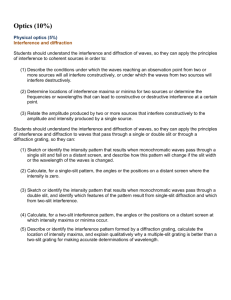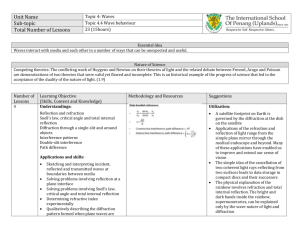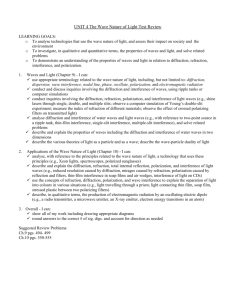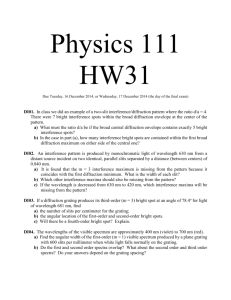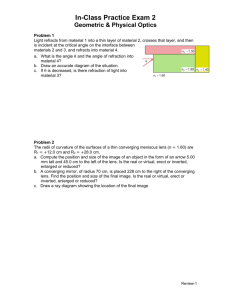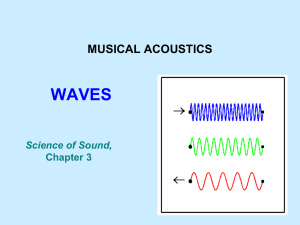Optics - Fulton County Schools
advertisement
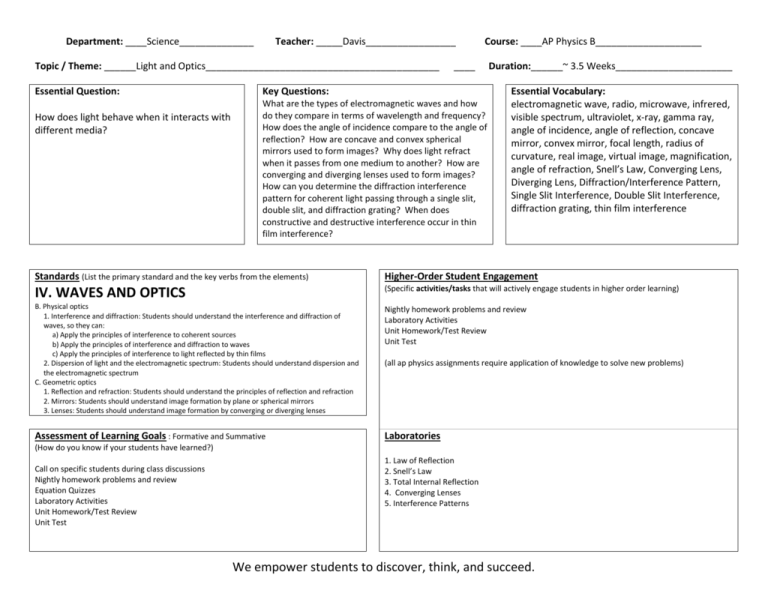
Department: ____Science______________ Teacher: _____Davis_________________ Topic / Theme: ______Light and Optics____________________________________________ Essential Question: How does light behave when it interacts with different media? Course: ____AP Physics B____________________ ____ Key Questions: What are the types of electromagnetic waves and how do they compare in terms of wavelength and frequency? How does the angle of incidence compare to the angle of reflection? How are concave and convex spherical mirrors used to form images? Why does light refract when it passes from one medium to another? How are converging and diverging lenses used to form images? How can you determine the diffraction interference pattern for coherent light passing through a single slit, double slit, and diffraction grating? When does constructive and destructive interference occur in thin film interference? Duration:______~ 3.5 Weeks______________________ Essential Vocabulary: electromagnetic wave, radio, microwave, infrered, visible spectrum, ultraviolet, x-ray, gamma ray, angle of incidence, angle of reflection, concave mirror, convex mirror, focal length, radius of curvature, real image, virtual image, magnification, angle of refraction, Snell’s Law, Converging Lens, Diverging Lens, Diffraction/Interference Pattern, Single Slit Interference, Double Slit Interference, diffraction grating, thin film interference Standards (List the primary standard and the key verbs from the elements) Higher-Order Student Engagement IV. WAVES AND OPTICS (Specific activities/tasks that will actively engage students in higher order learning) B. Physical optics 1. Interference and diffraction: Students should understand the interference and diffraction of waves, so they can: a) Apply the principles of interference to coherent sources b) Apply the principles of interference and diffraction to waves c) Apply the principles of interference to light reflected by thin films 2. Dispersion of light and the electromagnetic spectrum: Students should understand dispersion and the electromagnetic spectrum C. Geometric optics 1. Reflection and refraction: Students should understand the principles of reflection and refraction 2. Mirrors: Students should understand image formation by plane or spherical mirrors 3. Lenses: Students should understand image formation by converging or diverging lenses Nightly homework problems and review Laboratory Activities Unit Homework/Test Review Unit Test Assessment of Learning Goals : Formative and Summative Laboratories (all ap physics assignments require application of knowledge to solve new problems) (How do you know if your students have learned?) Call on specific students during class discussions Nightly homework problems and review Equation Quizzes Laboratory Activities Unit Homework/Test Review Unit Test 1. Law of Reflection 2. Snell’s Law 3. Total Internal Reflection 4. Converging Lenses 5. Interference Patterns We empower students to discover, think, and succeed. GPS Standards (Optional) IV. WAVES AND OPTICS B. Physical optics 1. Interference and diffraction: Students should understand the interference and diffraction of waves, so they can: a) Apply the principles of interference to coherent sources in order to: (1) Describe the conditions under which the waves reaching an observation point from two or more sources will all interfere constructively, or under which the waves from two sources will interfere destructively. (2) Determine locations of interference maxima or minima for two sources or determine the frequencies or wavelengths that can lead to constructive or destructive interference at a certain point. (3) Relate the amplitude produced by two or more sources that interfere constructively to the amplitude and intensity produced by a single source. b) Apply the principles of interference and diffraction to waves that pass through a single or double slit or through a diffraction grating, so they can: (1) Sketch or identify the intensity pattern that results when monochromatic waves pass through a single slit and fall on a distant screen, and describe how this pattern will change if the slit width or the wavelength of the waves is changed. (2) Calculate, for a single-slit pattern, the angles or the positions on a distant screen where the intensity is zero. (3) Sketch or identify the intensity pattern that results when monochromatic waves pass through a double slit, and identify which features of the pattern result from single-slit diffraction and which from two-slit interference. (4) Calculate, for a two-slit interference pattern, the angles or the positions on a distant screen at which intensity maxima or minima occur. (5) Describe or identify the interference pattern formed by a diffraction grating, calculate the location of intensity maxima, and explain qualitatively why a multiple-slit grating is better than a two-slit grating for making accurate determinations of wavelength. c) Apply the principles of interference to light reflected by thin films, so they can: (1) State under what conditions a phase reversal occurs when light is reflected from the interface between two media of different indices of refraction. (2) Determine whether rays of monochromatic light reflected perpendicularly from two such interfaces will interfere constructively or destructively, and thereby account for Newton’s rings and similar phenomena, and explain how glass may be coated to minimize reflection of visible light. 2. Dispersion of light and the electromagnetic spectrum: Students should understand dispersion and the electromagnetic spectrum, so they can: a) Relate a variation of index of refraction with frequency to a variation in refraction. b) Know the names associated with electromagnetic radiation and be able to arrange in order of increasing wavelength the following: visible light of various colors, ultraviolet light, infrared light, radio waves, x-rays, and gamma rays. C. Geometric optics 1. Reflection and refraction: Students should understand the principles of reflection and refraction, so they can: a) Determine how the speed and wavelength of light change when light passes from one medium into another. b) Show on a diagram the directions of reflected and refracted rays. c) Use Snell’s Law to relate the directions of the incident ray and the refracted ray, and the indices of refraction of the media. d) Identify conditions under which total internal reflection will occur. 2. Mirrors: Students should understand image formation by plane or spherical mirrors, so they can: a) Locate by ray tracing the image of an object formed by a plane mirror, and determine whether the image is real or virtual, upright or inverted, enlarged or reduced in size. b) Relate the focal point of a spherical mirror to its center of curvature. c) Locate by ray tracing the image of a real object, given a diagram of a mirror with the focal point shown, and determine whether the image is real or virtual, upright or inverted, enlarged or reduced in size. d) Use the mirror equation to relate the object distance, image distance, and focal length for a lens, and determine the image size in terms of the object size. 3. Lenses: Students should understand image formation by converging or diverging lenses, so they can: a) Determine whether the focal length of a lens is increased or decreased as a result of a change in the curvature of its surfaces, or in the index of refraction of the material of which the lens is made, or the medium in which it is immersed. b) Determine by ray tracing the location of the image of a real object located inside or outside the focal point of the lens, and state whether the resulting image is upright or inverted, real or virtual. c) Use the thin lens equation to relate the object distance, image distance, and focal length for a lens, and determine the image size in terms of the object size. d) Analyze simple situations in which the image formed by one lens serves as the object for another lens. We empower students to discover, think, and succeed.
